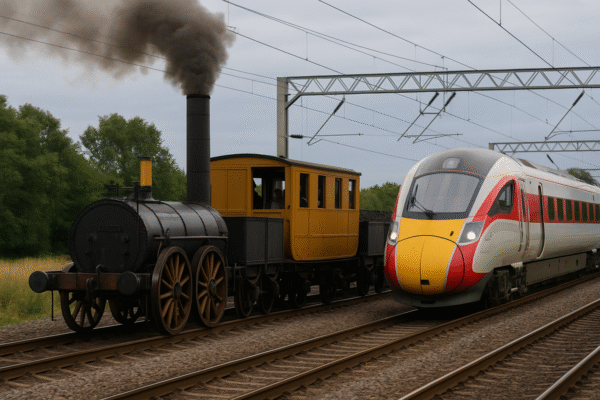The Stockton and Darlington Railway celebrated its 200th anniversary with events that drew thousands to northeast England. Visitors gathered to see a restored replica of George Stephenson’s Locomotion No. 1 run along parts of its original route. The moment combined nostalgia with anticipation, marking a turning point in both rail history and tourism.
The original journey took place on 27 September 1825. The train carried coal and passengers over 26 miles, proving steam locomotion could serve both industry and the public. The event reshaped Britain and laid the foundation for modern transport systems worldwide.
Celebration in Motion
The bicentenary featured a full re-enactment of the historic trip. Enthusiasts lined the route as the replica pulled coal wagons and a passenger coach. The sight brought history alive in a way that no museum exhibit could.
Prince Edward, Duke of Edinburgh, joined the celebrations, which underscored the event’s national importance. Locals and international visitors alike spoke of pride and wonder. A retired engineer described the replica run as an achievement worth every effort. Families said the experience gave them a new way to connect with Britain’s industrial story.
Rail Tourism Takes Center Stage
Tourism authorities see the bicentenary as more than a commemoration. It is also a chance to attract visitors to County Durham, Darlington, and surrounding towns. The Department for Transport emphasised the potential for cultural tourism linked to the birthplace of passenger rail.
Local tourism boards are expanding guided tours, exhibitions, and family-friendly activities. The Locomotion Museum in Shildon is preparing new interactive displays to engage younger audiences. Regional rail operators plan special anniversary ticket packages, offering tourists a blend of history and scenic landscapes.
Rail Improvements for Today’s Passengers
Alongside the celebrations, the government is investing in the modern railway network. The Railways Restored programme focuses on upgrading stations, adding digital signalling, and promoting greener fuels. These changes aim to make passenger journeys faster, safer, and more sustainable.
Tourists can expect better facilities, smoother connections, and experiences that combine heritage with modern comfort. Heritage-inspired train journeys are being discussed, blending historic charm with present-day convenience.
Linking Past and Present
The Stockton and Darlington Railway was not just a technological success. It changed the way goods and people moved across Britain. Coal, iron, and other resources reached ports and factories faster, fuelling industrial growth. The new system also allowed workers and families to travel in ways that once seemed impossible.
Today, the focus is on reducing carbon emissions and creating efficient transport links. The parallels are clear. The railway drove industrial expansion in the 19th century, and it now plays a key role in building a sustainable future.
A Community of Pride
Residents of Darlington and Stockton embraced the celebrations with enthusiasm. Many described the event as more than a commemoration. It was a shared experience that linked generations. Parents explained the railway’s role in history to their children. Historians mingled with first-time visitors eager to learn.
The atmosphere was one of optimism. Just as the original railway marked new beginnings, the bicentenary highlighted opportunities for growth in tourism and transport. The celebrations created a sense of continuity, linking past, present, and future.
Global Significance
While the railway began in northeast England, its influence spread far beyond. The model of a public passenger line on standard-gauge tracks inspired railways across Europe, Asia, and the Americas. The bicentenary therefore carries global significance. International visitors travelled to Darlington to see where the journey began.
For them, it was more than a holiday. It was a chance to stand where modern transport started, and to see how a small line reshaped the world. Tourism leaders believe this international interest will continue to grow in the coming years.
Looking Ahead
The bicentenary reminds Britain that rail is not only history but also the future. Investments in green technology, electrification, and hydrogen trains aim to keep the UK at the forefront of rail innovation. At the same time, heritage events and museums ensure that the story of 1825 remains accessible to new generations.
County Durham and Darlington now sit at the crossroads of heritage and modernity. Visitors can step into the past while enjoying the benefits of today’s travel. This mix promises economic growth, cultural pride, and environmental progress.
A Living Legacy
As the celebrations closed, the atmosphere was hopeful. The Stockton and Darlington Railway had once opened new paths for Britain. Two centuries later, it continues to inspire.
Tourists left with memories of steam and history. Families carried stories that linked grandparents to grandchildren. Officials spoke of sustainability and investment. For all, the bicentenary was not simply a look back but a step forward.
The Stockton and Darlington Railway remains a living legacy. It connects tradition with progress, history with tourism, and heritage with the promise of tomorrow.
For more travel news like this, keep reading Global Travel Wire



















